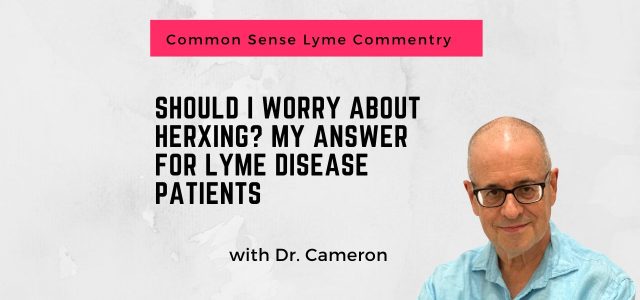Call for your appointment today 914-666-4665 | Mt. Kisco, New York

One of the biggest concerns Lyme disease patients have when beginning treatment is whether or not they will have a herxing response. In fact, it’s one of the most common questions I hear in my practice:
“What if I Herx?”
A Herxheimer reaction (or “Herx”) is a temporary flare of symptoms that can occur when treatment starts killing off bacteria faster than the body can clear them. It doesn’t happen to everyone, but when it does, it can feel overwhelming.
The good news? It’s manageable—and it’s often a sign that treatment is moving in the right direction.
Let’s break it down—in the form of a clinical dialogue.
💬 A Clinical Dialogue on Herxheimer Reactions
Cameron: A patient recently asked, “What happens if I Herx? I’ve read stories where people crash after antibiotics. Will that happen to me?”
Colleague: That’s a fair concern. A Herx can bring on a sudden wave of symptoms—like brain fog, headaches, joint pain, anxiety, fatigue, or even flu-like symptoms. Without preparation, it can be confusing and frightening.
Cameron: Right. I always tell patients a Herxheimer reaction is not the disease getting worse. It’s a response to microbial die-off. As the immune system clears dead bacteria, symptoms may temporarily spike. But it’s not failure—it’s feedback.
Colleague: How do you help patients recognize it?
Cameron: Timing matters. If symptoms flare a few days into treatment—or right after increasing a dose—it’s likely a Herx. But I don’t assume. I look at the pattern, ask about the timing, and rule out other causes. A clear response window tells us we’re seeing a Herx, not something else.
Colleague: And what do you do when it happens?
Cameron: We slow down. That might mean lowering the dose, pausing briefly, or supporting the patient with hydration, nutrition, and rest. My goal isn’t to push through—it’s to find a pace that works for their body.
Colleague: So it’s not “no pain, no gain”?
Cameron: Definitely not. Some Herxing is expected, but if it becomes overwhelming, we don’t ignore it. We respond. The goal is progress without crashing. The best outcomes I’ve seen are when we pace treatment with the patient—not against them.
🔬 What the Research and Experience Show
-
A Herxheimer reaction is a temporary immune and inflammatory response to bacterial die-off.
-
Common symptoms include:
– Fatigue
– Head pressure
– Dizziness
– Joint or muscle pain
– Brain fog
– Mood shifts or anxiety -
Most reactions occur within the first few days of starting or adjusting treatment.
-
Herxes typically resolve within hours to a few days, especially with pacing and basic support.
-
Slowing treatment or spacing doses can reduce severity without stopping progress.
⚖️ Why Clinical Judgment Still Matters
-
Not every flare is a Herx—some may be infection symptoms, medication side effects, or other imbalances.
-
I track the onset and progression of symptoms to better understand what’s happening.
-
When patients Herx too strongly, I don’t push through—I adapt.
-
Managing a Herx is about reading the response, adjusting carefully, and maintaining trust in the treatment path.
🩺 What I Do in My Practice
-
I educate patients about Herxheimer reactions before we begin treatment.
-
I encourage regular check-ins—especially during the first few weeks.
-
I adjust medications or timing when needed to keep symptoms manageable.
-
I recommend simple support: rest, hydration, magnesium, and time.
-
I reassure patients: a strong reaction isn’t a setback—it’s part of the process.
🧭 Final Thoughts
Herxing can feel like a step backward—but often, it’s a step forward that needs more support.
If you Herx, it doesn’t mean you’re too weak for treatment. It means your body is working—and needs a little help keeping pace.
In my practice, we don’t power through a Herx. We slow down, regroup, and keep moving—at the body’s speed.
Healing doesn’t require suffering. It requires paying attention. And we do that together.




Stratton at Vanderbilt University made numerous studies and write numerous papers on treating chlamydia pn and the secondary porphyria event. When someone has any genetic propensity to porphyria – the die off of intracelular bacteria can dump porphyregans into the system; he called it secondary porphyria. He wanted patients to treat this first before gradually increasing abx or any killing. He put people in high carb diets, hefty B complex and anti oxidants, B12 especially and activated charcoal. After their porphyria was controlled then tolerating the antimicrobials was much easier. The signs and symptoms of a porphyria are usually acute stomach pain, dark urine, and upper body neuropathy and often severe psychiatric symptoms; even psychosis. . If not treated a severe attack can lead to respiratory failure. Stratton never studied Lyme bacteria but I wonder if we are not often seeing the same thing and confusing it for herx. In its infinite wisdom the maters of internet governance have scrubbed clean the ability to access much of his work; especially from the USA. Perhaps because he aligned himself with a community who thought MS was ultimately due to systemic chlamydia. Regardless, it’s worth looking at symptoms if patients stating on anti microbials and backing off, supporting this protocol and choosing only porphyria safe drugs, sincerely, Angela Berry Koch, researcher and masters of science from LSHTM.
I have not heard of the potential role of Porphyrins in a Herxheimer reaction. Thanks for sharing
I feel like I had a herx reaction. I started feeling bad and my feet and hands got extremely cold. I will stand and my body felt vibrating inside. So I checked with oximitor from home placed on finger and it rad 98% oxigen 56 heart rate but it would fluctuate up to 90. My pi was only 1.8 to 2.2 on my hand and feet. I went to bed worried. I’m on 100m of dyoxicline twicea day. Should I reduce to one a day for a day or 2?
I have Lyme disease patients with dysautonomia as thier main symptoms. You can read more https://danielcameronmd.com/autonomic-dysfunction-lyme-disease/